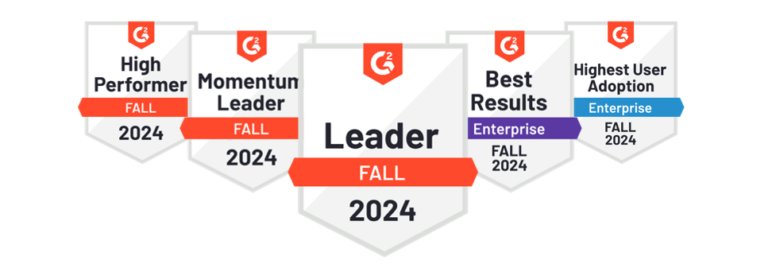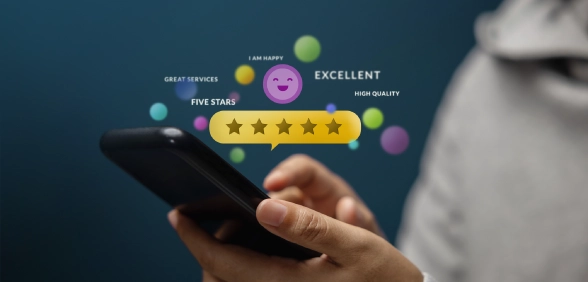CSAT and NPS: Differences and Similarities
Meet Sarah, a CEO of a rapidly growing skincare brand. Her company is on its way to becoming the fastest growing skincare line of the decade, but something’s holding her back. She’s struggling to understand how her customers really feel about her brand and her products across the brand’s multiple retail locations. As her business gets larger, it seems to become more challenging to listen to every voice.
She’s not alone on this one. Many businesses also experience this issue. Luckily, metrics like CSAT (Customer Satisfaction Score) and NPS (Net Promoter Score) can cut through the uncertainty and provide insight into how customers truly feel across every branch.
You, like Sarah, may want to better understand the best formula to providing customer satisfaction. You may want to know how your customers really feel about your product or service, what you can do better, and what you’re doing extremely well. Is there a secret formula that your competitors are using that you don’t know about?
CSAT and NPS are not just vanity metrics; they hold the answer to why your customers stay or find a better experience elsewhere. A company that prioritizes these metrics is miles ahead of its competitors who are struggling to piece together why they are experiencing so much churn or why their business isn’t growing.
This blog post is for the Sarah of every industry who knows that their next breakthrough lies in the heart of understand their customer’s feedback.
What is CSAT (Customer Satisfaction Score)?
CSAT Meaning
CSAT stands for Customer Satisfaction – a metric that can give you deeper insights into your customer’s happiness and the quality of their experiences. The CSAT measurement can serve as a direct line to your customer’s thoughts and needs. It helps in churn reduction and business growth.
More about CSAT
When you know how satisfied your customers are, you can tailor your services to make their lives easier, better, and more delightful. It’s a quick temperature check on the health of your customer relationships, enabling you to respond rapidly to their needs.
Example of a CSAT Survey
A simple question after a service interaction asking, “How would you rate your satisfaction with our service today?” or “How satisfied are you with the recent service you received at our company x ?” This serves as an invitation for your customers to tell you about their experience, turning every feedback into a stepping stone for improvement.
CSAT Score
- 5 point scale: Easy and intuitive, this scale offers your customers a straightforward way to express how they feel about your service. It translates complex emotions into clear actionable data.
- 7 point scale: With more granularity, you get a finer understanding of their satisfaction levels. The more you know, the better you can make their experience with your brand.
The Science and History Behind CSAT
CSAT is a tried and tested pathway to earning customer trust and loyalty.
The formal measurement of customer satisfaction took shape with the establishment of the American Customer Satisfaction Index (ACSI) by the University of Michigan in 1994. This marked the beginning of CSAT as we know it, setting the stage for businesses to measure and understand the value of their goods and services from the customer’s viewpoint.
Over time, CSAT has been recognized as a vital performance indicator within the business realm, integral to strategic planning and management systems like the Balanced Scorecard. The data gleaned from CSAT surveys serve a dual purpose: they underscore the importance of customer care within an organization and predict future buying behaviors and customer loyalty.
Benefits of Using CSAT as a Measure
When you use CSAT, you’re not just collecting data; you’re opening a dialogue. This metric guides your business decisions towards customer-centricity. And when your customers see their feedback shaping your services, they feel valued and more connected to your brand.
When to use CSAT: Ideal Scenarios
Immediate Post-Interaction Feedback
Right after a service moment (such as after an episode/touchpoint), CSAT can capture their raw impression. Immediate feedback allows you to celebrate wins or put out fires before they spread.

Assessing Specific Transactions or Interactions
CSAT helps you dive deep into specific touchpoints. It helps you perfect moments that matter the most to your customers.

Evaluating Short-Term Experiences
For quick engagements, CSAT can be your quick-check metric. It ensures that even the briefest encounters with your brand are memorable and satisfying and opens suggestions for improvement.
What is NPS (Net Promoter Score)?
One of the most popular metrics used by companies across the globe to measure customer advocacy is the Net Promoter Score (NPS). But what exactly is NPS, and how can it transform your customer relationship management? Let’s dive in.
NPS Meaning

NPS is a metric used to gauge customer advocacy and satisfaction with a single, straightforward question: “On a scale from 0 to 10, how likely are you to recommend our company/product/service to a friend or colleague?” Based on the responses, customers are categorized into three segments: Promoters, Passives, and Detractors. This simplicity and direct correlation to customer behavior make NPS a powerful tool for businesses.

NPS Score
The NPS score is calculated by subtracting the percentage of customers who are Detractors (those who give a score of 6 or below) from the percentage of Promoters (those who give a score of 9 or 10). Passive scores (7-8) are not directly factored into the calculation but are important for gauging the potential for increased customer satisfaction. The final NPS score can range from -100 (everyone is a detractor) to 100 (everyone is a promoter), with a higher score indicating a healthier relationship with your customers.
NPS Examples
Regularly monitoring NPS, companies can identify trends, predict business growth, and understand the impact of specific actions on customer loyalty. For example, a software company wants to assess customer loyalty. They send out an NPS survey asking recent shoppers:
“How likely are you to recommend our company to a friend or colleague?”
After compiling responses, they find:
- 70% are Promoters (rating 9-10)
- 20% are Passives (rating 7-8)
- 10% are Detractors (rating 0-6)
The NPS is calculated by subtracting the percentage of Detractors from the percentage of Promoters: 70% – 10% = an NPS of 60.
The high NPS suggests customers had a positive experience with the new ordering system and are likely to recommend the retailer, indicating strong customer loyalty and potential for organic growth through word-of-mouth.
Type of NPS and when to use them
NPS can be categorized into 3 main types, each offering unique insights into customer sentiment.
- Relationship NPS
Relationship NPS is the broadest measure of customer loyalty to a brand. It gauges a customer’s overall sentiment towards your company and the likelihood of them recommending it to others. This score is often captured through regular survey intervals, such as quarterly or annually, and is not tied to any particular transaction or interaction.
For instance, a streaming service might ask their subscribers: “Considering your overall experience with us, how likely are you to recommend our service to a friend?” The resulting data helps the company understand long-term loyalty and satisfaction, beyond any one show or feature.
- Episodic NPS
While Relationship NPS takes a step back, Episodic NPS zooms in on specific episodes or periods of customer interaction. This could be an engagement over a season, like holiday shopping, or during a particular event, like a product launch.
A resort, for example, could send an NPS survey post-stay during the summer season asking: “Based on your summer stay at our resort, how likely are you to recommend us?” Episodic NPS can reveal the impact of seasonal promotions, operational changes, or market shifts.
- Transactional / Touchpoint
The most granular of the NPS types, Transactional or Touchpoint NPS, captures immediate customer feedback after a specific interaction or transaction. This could be after a support call, a purchase, or the use of a product or service.
Consider a customer who just interacted with a tech support team; they might receive a survey asking: “Based on the support call you had today, how likely are you to recommend our products?” This score can pinpoint strengths and weaknesses in particular touchpoints, allowing businesses to react swiftly and improve the customer experience in almost real-time.
The Science and History Behind NPS
Years ago, Fred Reichheld and his colleagues at Bain initiated a study to see if a simple method could better predict customer loyalty. They worked with Satmetrix, sifting through different questions to see which one best forecasted customer value over time.
They discovered the most effective question for gauging future growth in several industries was: “Would you recommend our company to someone you know?”
Getting high marks on this question was a strong sign that customers would keep buying and refer others, which drives company growth. This one query, the likelihood to recommend, stood out in nearly all cases they studied.
This question is central to what’s known as the Net Promoter Score (NPS), a key metric now used by countless companies, including the majority of the Fortune 1000.
Yet, just calculating the NPS isn’t enough. They learned it’s vital to understand why customers gave their scores. This insight is crucial for continual improvement. To move from just scoring to actually enhancing performance, they developed what’s known as the Net Promoter System.
NPS is grounded in the psychological principle that customer behavior is predictive of business growth. By asking one simple question, companies tap into the customer’s propensity to promote their experience. The responses are classified into three categories: Promoters, Passives, and Detractors. The science of NPS lies in its ability to transform these subjective responses into a quantifiable metric that correlates with revenue growth and customer retention.
The methodology is robust yet straightforward: subtract the percentage of Detractors from the percentage of Promoters to get a score between -100 and 100. This score is a leading indicator of future business performance, as numerous studies have shown a strong correlation between high NPS and organic growth.
Benefits of Using NPS
Here are some of the benefits of deploying NPS as part of your business strategy:
- Actionable Insights: NPS cuts through the noise to provide clear, actionable insights into customer satisfaction and loyalty.
- Predictive Power: A high NPS is often a precursor to growth, as it reflects the likelihood of word-of-mouth referrals.
- Competitive Benchmarking: Comparing your NPS with industry benchmarks allows for strategic alignment and competitive analysis.
- Customer-Centric Culture: Regular NPS tracking fosters a culture of customer-centricity, encouraging continuous improvement based on feedback.
When to Use NPS
NPS is a versatile metric that can be utilized at various junctures in the customer lifecycle:
- After Key Interactions: Post-purchase or service encounters are prime moments to solicit NPS feedback, providing immediate insights into the customer experience.
- Throughout a customer Relationship : Periodic NPS surveys can help gauge overall satisfaction and loyalty, offering a long-term view of the customer-brand relationship.
- Following Changes or Updates: Implementing changes to products or services warrants an NPS survey to assess the impact from a customer perspective.
CSAT vs NPS
Comparing CSAT and NPS: Which is Better and When?
Have a look at the table below to check the similarities and differences of CSAT and NPS
| CSAT | NPS | |
| “How satisfied are you with our product” | “How likely are you to recommend us to a friend?” | |
| Purpose | For specific areas of interest | For gauging entire business angle |
| Metric | Transactional metric | Loyalty metric |
| Goal | Product/service experience perception | Brand perception |
| Focus | Focus on satisfaction | Focus on recommendation |
| Period of evaluation | Specific events | Long-term customer experience |
| Question | More versatile | Limited to a single question type |
| Frequency (Best option) | Transactional or Episodic | Overall Relationship and Episodic |
| Format | 5-7 point scale | 10-point scale |
Here’s a quick application checklist:
| CSAT | NPS | |
| Understand customer loyalty | ❌ | ✔️ |
| Understand the likelihood of referring the product/service | ❌ | ✔️ |
| Understand the satisfaction on a particular product/service | ✔️ | ❌ (Can be done but not ideal) |
| Understand brand perception | ✔️ | ✔️ |
| Feedback on specific tasks on processes | ✔️ | ❌ (Can be done but not ideal) |
| Understand customer experience | ✔️ | ✔️ |
Hybrid Approaches: Can CSAT and NPS Work Together?
A hybrid approach combines the immediacy of CSAT with the long-term perspective of NPS, providing a 360-degree view of the customer experience. By employing both metrics, businesses can:
- Address specific issues immediately (CSAT) while also building long-term loyalty (NPS).
- Balance tactical responses with strategic planning.
- Tailor customer experiences based on detailed insights from both transactional and relational feedback.
Tools and Technologies: Enhancing CSAT and NPS Data Collection
Advancements in customer experience tools and technologies have made it easier to collect, analyze, and act on CSAT and NPS data. Businesses are now equipped to:
- Use automated survey platforms to gather feedback across various touchpoints.
- Implement analytics software to identify trends and predict behaviors.
- Leverage AI and machine learning to personalize responses and improve customer satisfaction proactively.
Making the Right Choice for Your Business
The choice between CSAT and NPS is not binary. The most insightful approach often involves a blend of both, informed by the unique needs and goals of your business. While CSAT can guide immediate improvements, NPS can shape long-term strategies. Together, they can provide a nuanced understanding of your customers, empowering your business to deliver exceptional experiences that drive loyalty and growth.
At Resonate, you have the platform to listen, understand, and act upon customer feedback. You’re not just adopting a metric to understand the real customer sentiment; you’re embracing a partnership elevates your customer satisfaction to new heights.







